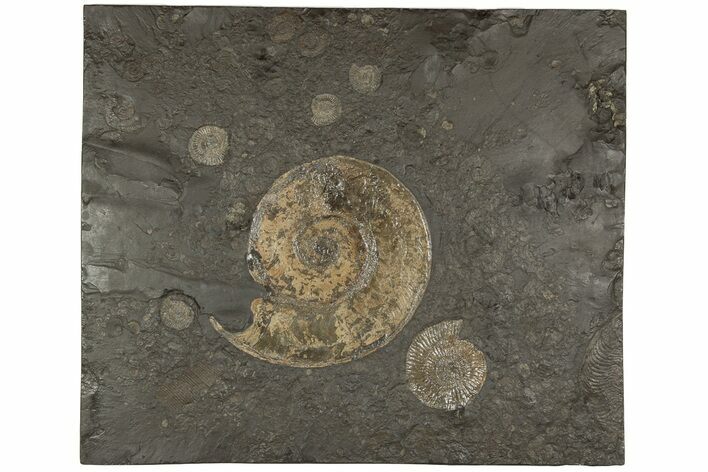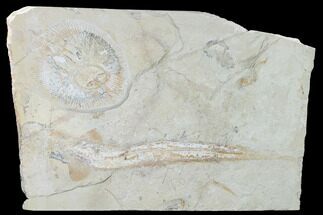This Specimen has been sold.
20" Plate Of Pyritized Ammonite Fossils - Posidonia Shale, Germany
This is a 20.6 x 17.4" section of shale covered in pyrite replaced ammonite fossils from the Posidonia Shale of Germany. The largest ammonite is a 8.8" wide Harpoceras which is surrounded by over a dozen, smaller Dactylioceras ammonites.
The shale has been rectangularly cut and coated in a sealant to preserve the fossils. We can either provide a display stand with this piece or add a backing and wall hanger upon request.
The shale has been rectangularly cut and coated in a sealant to preserve the fossils. We can either provide a display stand with this piece or add a backing and wall hanger upon request.
About Ammonites
Ammonites were ancient marine cephalopods, similar to today's squids and octopuses, but with a defining feature: their distinctive, tightly coiled spiral shells. These shells, resembling those of modern nautiluses, served as both a protective home and a buoyancy aid, allowing ammonites to navigate the prehistoric seas with ease. First emerging around 240 million years ago in the Triassic Period, ammonites thrived for over 175 million years, adapting through numerous forms and sizes. As predatory creatures, they likely fed on smaller marine organisms, using their tentacles to capture prey. However, their long reign came to an end 65 million years ago at the close of the Cretaceous, coinciding with the mass extinction event that also eliminated the dinosaurs.
Ammonites were ancient marine cephalopods, similar to today's squids and octopuses, but with a defining feature: their distinctive, tightly coiled spiral shells. These shells, resembling those of modern nautiluses, served as both a protective home and a buoyancy aid, allowing ammonites to navigate the prehistoric seas with ease. First emerging around 240 million years ago in the Triassic Period, ammonites thrived for over 175 million years, adapting through numerous forms and sizes. As predatory creatures, they likely fed on smaller marine organisms, using their tentacles to capture prey. However, their long reign came to an end 65 million years ago at the close of the Cretaceous, coinciding with the mass extinction event that also eliminated the dinosaurs.
SPECIES
Harpoceras & Dactylioceras
LOCATION
Holzmaden, Germany
FORMATION
Posidonia Shale
SIZE
Plate 20.6 x 17.4", Largest Ammonite 8.8"
CATEGORY
SUB CATEGORY
ITEM
#192188
We guarantee the authenticity of all of our specimens.
 Reviews
Reviews














